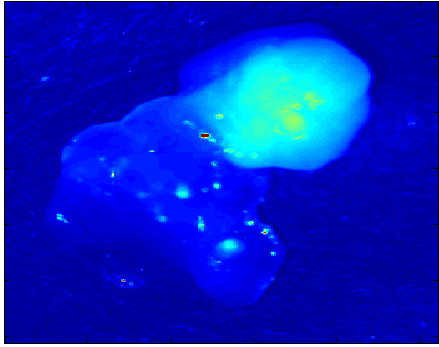Detecting Parathyroid Gland Intraoperatively
 Endocrine surgery traditionally involves meticulous dissection and resection of diseased glands while leaving the normal glands intact, guided only by visual recognition. Inadvertent removal of parathyroid glands is a recognized complication of this procedure leading to complications such as postoperative hypocalcemia and hypoparathyroidism that could have consequences on the long-term regulation of calcium homeostasis post-operatively. There is a need for an identification tool that provides sensitive, real-time detection of parathyroid glands during surgery. Optical spectroscopy and imaging are powerful tools that can aid in the detection of tissue physiology and pathology. Preliminary fiber probe and imaging measurements have shown that the parathyroid exhibits higher levels of near-infrared (NIR) autofluorescence in comparison to all other tissues in the neck. The main objective of this project then is to develop a technique based on NIR autofluorescence that enables intraoperative detection of parathyroid glands such that accidental removal is minimized by supplementing the standards of visual
inspection. Aspects of the project include: (1) characterizing the NIR fluorescence signatures of parathyroid and thyroid tissues, (2) studying the basis of the observed differences in the spectral characteristics, (3) developing a software interface and automating data acquisition and along with a next-generation clinical system, (4) collecting a large patient database and performing retrospective and prospective evaluation discrimination algorithms and studying the effect of the disease state on spectral measurements and (5) assessing lymph nodes for the presence of thyroid or parathyroid cancer. The results of the proposed work will have a significant impact on health care by providing guidance towards dissection and resection of thyroid and parathyroid tissues. This would potentially result in fewer complications due to accidental injury or incomplete removal of parathyroid tissue. Also check out how we use laser speckle contrast imaging to assess the viability of parathyroid gland here.
Endocrine surgery traditionally involves meticulous dissection and resection of diseased glands while leaving the normal glands intact, guided only by visual recognition. Inadvertent removal of parathyroid glands is a recognized complication of this procedure leading to complications such as postoperative hypocalcemia and hypoparathyroidism that could have consequences on the long-term regulation of calcium homeostasis post-operatively. There is a need for an identification tool that provides sensitive, real-time detection of parathyroid glands during surgery. Optical spectroscopy and imaging are powerful tools that can aid in the detection of tissue physiology and pathology. Preliminary fiber probe and imaging measurements have shown that the parathyroid exhibits higher levels of near-infrared (NIR) autofluorescence in comparison to all other tissues in the neck. The main objective of this project then is to develop a technique based on NIR autofluorescence that enables intraoperative detection of parathyroid glands such that accidental removal is minimized by supplementing the standards of visual
inspection. Aspects of the project include: (1) characterizing the NIR fluorescence signatures of parathyroid and thyroid tissues, (2) studying the basis of the observed differences in the spectral characteristics, (3) developing a software interface and automating data acquisition and along with a next-generation clinical system, (4) collecting a large patient database and performing retrospective and prospective evaluation discrimination algorithms and studying the effect of the disease state on spectral measurements and (5) assessing lymph nodes for the presence of thyroid or parathyroid cancer. The results of the proposed work will have a significant impact on health care by providing guidance towards dissection and resection of thyroid and parathyroid tissues. This would potentially result in fewer complications due to accidental injury or incomplete removal of parathyroid tissue. Also check out how we use laser speckle contrast imaging to assess the viability of parathyroid gland here.
| Signal from parathyroid (dashed line), thyroid (dotted line) and fat, muscle and trachea. Each spectra is taken as the average of 6 measurements at the site of investigation. The parathyroid signal is significantly stronger than the anything else in the neck. It is seven times greater than the thyroid and its peak intensity. |
